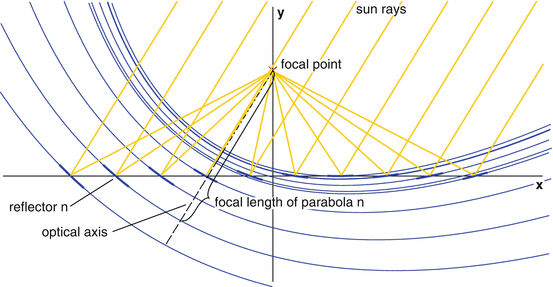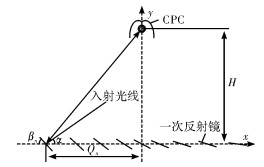
A LFR has a similar effect to a parabolic trough, when considering the concentration of the radiation in a focal line i.e. In an analogous way, a linear Fresnel mirror can be constructed substituting a parabolic trough by linear segments that focus the radiation that arrives in a plane parallel to the symmetry plane of the parabolic trough onto the focal line of the parabolic trough.

It is possible to divide a parabolic mirror into annular segments, forming a circular Fresnel mirror which focuses the light that arrives in rays parallel to the optical axis onto the focal point of the paraboloid mirror. The principle of dividing an optical element into segments which have the same (or a very similar) optical effect as the original optical element can also be applied to mirrors. Where the purpose is to focus a source of light this impact on the image quality is not of major importance. This allows a substantial reduction in thickness (and thus weight and volume) of the lens, at the expense of reducing the imaging quality of the lens. The principle of this lens is the breaking of the continuous surface of a standard lens into a set of surfaces with discontinuities between them.

The linear Fresnel reflector technology receives its name from the Fresnel lens, which was developed by the French physicist Augustin-Jean Fresnel for lighthouses in the 18th century. LFRs have great potential in southern Africa due to the low cost and high percentage of local manufacture inherent in the technology. Applications range from industrial process heat, distributed power generation using the organic Rankin cycle to steam turbine systems.ĭevelopments in energy efficiency in both industry and power generation have focused attention on medium and high temperature solar thermal systems. Originally designed for low and medium power applications, LFRs are now being designed for higher temperatures which facilitate direct steam generation (DSG) which can be used efficiently in the industrial or power generation sector.įresnel systems can be configured to operate over a wide range of temperatures, from 200 to 500☌, although systems with temperatures as high as 550☌ are under development. The main advantage of LFR systems is that their simple design of flat or flexibly bent mirrors and fixed receivers requires lower investment costs and offers a wide range of configurations. These advantages can offset the lower solar-to-heat efficiency, and LFR power plants represent an interesting alternative to parabolic trough power plants. In addition, Fresnel solar fields permit higher land use efficiency than any other type of solar fields.

The considerable economic advantages of Fresnel collectors are principally related to their constructive simplicity. The main reason for this is the search for cheaper solar field solutions. Nevertheless, in the last decade LFR systems have aroused an increasing interest. For that reason CSP development efforts have concentrated on parabolic trough geometry. Parabolic troughs represent the optimal solution for achievable concentration ratio and achievable energy yield per aperture area and, hence, the best overall plant efficiency in line-focussing mirror systems. LFR plant is highly modular, ranging from a few hundred kW to several MW in size, and offers the lowest land occupancy compared to other CSP technologies.


 0 kommentar(er)
0 kommentar(er)
